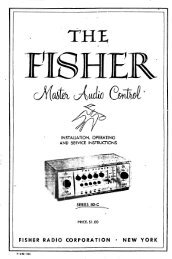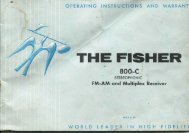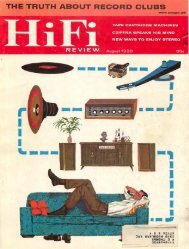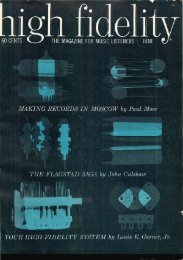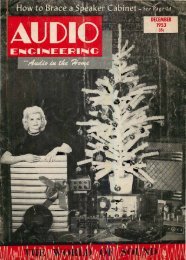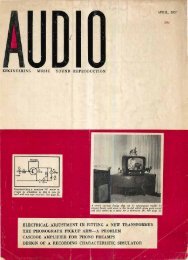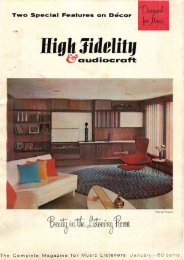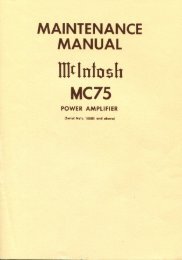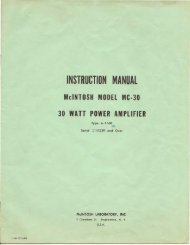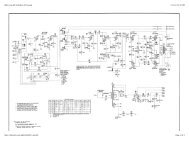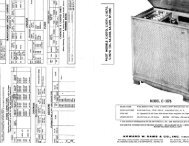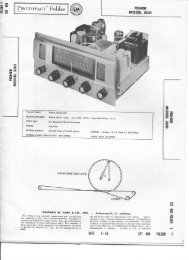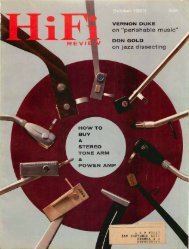~flr'6,r"®
Hifi Stereo Review â July 1958 - Vintage Vacuum Audio
Hifi Stereo Review â July 1958 - Vintage Vacuum Audio
- No tags were found...
Create successful ePaper yourself
Turn your PDF publications into a flip-book with our unique Google optimized e-Paper software.
Ei leen Farrell (soprano) with the Philharmonia<br />
Orchestra, Thomas Schippers condo<br />
Angel 35589.<br />
Of these tlu'ee artists only Tozzi is a<br />
member of the Metropolitan Opera Company.<br />
That both Simoneau mld Farrell<br />
are not is rather a scandalous thing, for<br />
both have long since proved themselves<br />
among the most distinguished vocalists<br />
of our day.<br />
The Tozzi disc is a virtual panorama in<br />
capsule of all the great bass arias from<br />
the Mozart and Verdi repertoire. Francis<br />
Robinson, in his liner notes, emphasizes<br />
what must be abundantly clear: Tozzi is<br />
looked upon by both the Metropolitan<br />
and RCA Victor as the successor to Pinza.<br />
If this disc shows that he does not yet<br />
have the imposing vocal dignity of Pinza<br />
at his prime, it does firmly establish Tozzi<br />
as an impressive exponent of these roles.<br />
If increased experience brings with it a<br />
more authoritative conunand of the nuances<br />
and su btIeties of these parts, then<br />
Tozzi will indeed be an artist in the grand<br />
tradition.<br />
Though Simoneau is known in this<br />
country primarily as a concert singer, in<br />
Europe his most lasting fame derives<br />
from his operatic appearances. He sings<br />
the arias on his recital disc witI1 a purity<br />
of style and ease of production that make<br />
one long to hem' him essay in the Besh<br />
the standard lyric tenor operatic roles.<br />
The Farrell disc is but a harbinger of<br />
things to come. TIns superlative singer,<br />
who has been shamefully neglected by the<br />
recording industry for a decade and a<br />
half, is at long last beginning to receive<br />
her due; in addition to the present Angel<br />
release, she will shortly appear on the<br />
RCA Victor label with Charles Munch<br />
and the Boston Symphony in performances<br />
of B1'unnhilde's Immolation and<br />
Isolde's Liebestod, and I hear that she<br />
has been busy recording for Columbia<br />
with Leonard Bernstein. As displayed in<br />
the Angel disc the voice is now at the<br />
very height of its perfection, with a vibrance<br />
and a ring that are tlu·illing. Outstanding<br />
are the Ad'ietl, Forets from<br />
Tchaikovsky's Jeanne d' ATC and To this<br />
'We've Game from Menotti's The Gonsul.<br />
Excellent accompaniment from Schippers<br />
and the Philllarmonia complete an extraordinary<br />
release.<br />
M. B.<br />
58<br />
Iberia, Bach, Brazil<br />
• FALLA: Concerto for Harpsichord and<br />
Chamber Ensemble.<br />
Robert Veyron-Lacroix with Soloists of the<br />
National Orchestra of Spain, Ataulfo Argenta<br />
condo Master Peter's Puppet Sho w<br />
(complete opera). Julita Bermejo (soprano),<br />
Carlos Mungiua (tenor), Raimundo Torres<br />
(baritone) with above orchestra and conductor.<br />
London LL 1739.<br />
VolWlle 8 of tins series is a gem, which<br />
features two of Manuel de Falla's finest<br />
masterpieces. The 14-minute Harpsichord<br />
Concerto of 1923-26 is a neoclassic creation<br />
of wonderfully corrosive sonority. It<br />
is short in time span, but redolent with<br />
significance on many levels. Performance<br />
and recording are properly sharp-edged,<br />
with the harpsichord appropriately clangorous.<br />
Do check the other available recording,<br />
by Sylvia Marlowe; I recall her<br />
performance from concert also as being<br />
extraordinary.<br />
Master Peter's Puppet Show is one of<br />
the most enchanting of all contemporary<br />
stage pieces, an excerpt adapted from<br />
Cervantes and set to music with utter<br />
genius. Dated 1923, this little 27-minute<br />
opera is here superbly paced by tile late<br />
and much-lamented Argenta, and the<br />
singing of Maese Pedro and the Boy-Crier<br />
is outstanding; I have heard, however, the<br />
part of Don Quixote less raucously delivered.<br />
The other two current versions,<br />
both sung in Spanish, are not to be ignored.<br />
K. G. R.<br />
• VI LLA·LOBOS: Bachianas Brasileiras<br />
Nos. 2, 5, 6, 9.<br />
French National Radio Orchestra, Flute and<br />
Bassoon Soloists, Victoria de los Angeles<br />
(soprano), H eitor Vill a-Lobos condo Angel<br />
35547.<br />
Villa-Lob os may be the most productive<br />
composer living, and at the same time<br />
tile least self-critical. I admit to belonging<br />
to that minority which considers tile<br />
title Bachianas pretentious and inappropriate.<br />
According to the composer, the<br />
nine suites were "inspired by the musical<br />
atmosphere of Bach in respect to harmony<br />
ancl counterpoint and by the melodic atmosphere<br />
of the folk music of Brazil's<br />
nortIleastern region." Yet these pieces<br />
have less to do with Bach tIlan just about<br />
anything by Hindemith. No.2 is diverting<br />
movie music ( it includes The Little<br />
Train of the Gaipira-pure Disneyland);<br />
No. 4 for Bute and bassoon is dryas dust,<br />
a fake invention with some interesting<br />
moments, and No. 9 for string orchestra<br />
begins well but seems never to end.<br />
No. 5 still remains a jewel, a real inspiration.<br />
Miss de los Angeles sings both<br />
sections, the Aria and the Dansa, and<br />
very well too-especially the scintillating<br />
second. In the first she has memorable<br />
competition from Bidu Sayao's vintage<br />
recording; Phyllis Curtin's I have not<br />
heard; but I cannot imagine any better<br />
singing than by the fabulous young Salli<br />
Terri on Capitol's Duets with the Spanish<br />
Guitar (L. Amleida). Sonorous recording,<br />
nice to turn up big and let roll.<br />
K. G. R.<br />
Hungary's Voice in L. A.<br />
• ROSZA: Concert Overture, Op. 26;<br />
Three Hungarian Sketches, Op. 14; Theme,<br />
Variations, and Finale.<br />
Frankenland State Symphony Orchestra.<br />
Miklos Rosza cond o Decca DL 9966.<br />
When we think of 20th century music<br />
by Hungarian composers, the names of<br />
Bartok, Kodaly, and D ohnanyi come instantly<br />
to mind. It is now clear that we<br />
must add the name of Miklos Rozsa to<br />
this list. An increasing number of recordings<br />
bears testimony tIlat Rozsa is not<br />
just a good movie composer (he has been<br />
in Hollywood since 1940 where he composed<br />
such notable film scores as The<br />
Jungle Book); he is a good composer.<br />
His music is made with extraordinary<br />
skill, as one would expect. It also has a<br />
personal style and a strong degree of<br />
communicative substance. AltIlougb he<br />
owes something to HindemitIl, Rozsa<br />
sounds like a Hungarian, and that means<br />
vital rhythm and riell col or. Less original<br />
and searching tIlan Bartok, he is nevertheless<br />
inventive and imaginative; his work is<br />
alive and Bavorful, and only in recent<br />
years has some of the celluloid slickness<br />
rubbed off harmfully onto his concert<br />
music.<br />
The Theme, Variations and Finale<br />
dates from 1933, when Rozsa was only<br />
26. It is a superb piece which has ah'eady<br />
been widely played and which deserves<br />
frequent rehearing. The Tlu'ee Hungarian<br />
Sketches of 1938 are captivating and<br />
saucy. They are highlighted by the exploitation<br />
of outrageously effective timbres<br />
within a quite irresistible rhythmic<br />
framework. The Concert Overture of<br />
1956, though solid and impressive, fails to<br />
catch fim.<br />
That Rozsa is also an estimable conductor<br />
is proved by the astonishingly brilliant<br />
perforn1ances he conjures out of the<br />
Frankenland State Symphony Orchestra.<br />
George Jellinek's notes are detailed and<br />
informative, and the sound is nrst-c1ass.<br />
Let's forget all about the movies as far<br />
as Mr. Rozsa is concerned and begin to<br />
discover him as the composer of consequence<br />
he is.<br />
K. G. R.<br />
HIFI & MUSIC REVIEW<br />
J<br />
I<br />
'~




